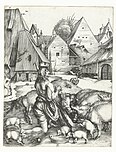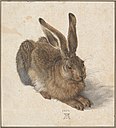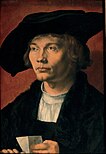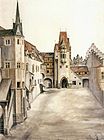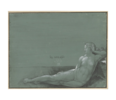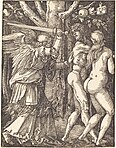Albrecht Dürer
Albrecht Dürer | |
|---|---|
 Dürer's Self-portrait at 26 at Prado Museum | |
| Born | 21 May 1471 |
| Died | 6 April 1528 (aged 56) Nuremberg, Free Imperial City of Nuremberg, Holy Roman Empire |
| Nationality | German |
| Other names |
|
| Known for | |
| Notable work | |
| Movement | |
| Spouse | |
| Signature | |
Albrecht Dürer (/ˈdjʊərər/ DURE-ər,[1] German: [ˈalbʁɛçt ˈdyːʁɐ];[2][3][1] 21 May 1471 – 6 April 1528),[4] sometimes spelled in English as Durer, was a German painter, printmaker, and theorist of the German Renaissance. Born in Nuremberg, Dürer established his reputation and influence across Europe in his twenties due to his high-quality woodcut prints. He was in contact with the major Italian artists of his time, including Raphael, Giovanni Bellini and Leonardo da Vinci, and from 1512 was patronized by Emperor Maximilian I.
Dürer's vast body of work includes engravings, his preferred technique in his later prints, altarpieces, portraits and self-portraits, watercolours and books. The woodcuts series are stylistically more Gothic than the rest of his work, but revolutionised the potential of that medium, while his extraordinary handling of the burin expanded especially the tonal range of his engravings; well-known engravings include the three Meisterstiche (master prints) Knight, Death and the Devil (1513), Saint Jerome in his Study (1514), and Melencolia I (1514). His watercolours mark him as one of the first European landscape artists, and with his confident self-portraits he pioneered them as well as autonomous subjects of art.
Dürer's introduction of classical motifs and of the nude into Northern art, through his knowledge of Italian artists and German humanists, has secured his reputation as one of the most important figures of the Northern Renaissance. This is reinforced by his theoretical treatises, which involve principles of mathematics for linear perspective and body proportions.
Biography
[edit]Early life (1471–1490)
[edit]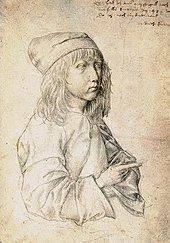
Dürer was born on 21 May 1471, the third child and second son of Albrecht Dürer the Elder and Barbara Holper, who married in 1467.[5][6] Albrecht Dürer the Elder (originally Albrecht Ajtósi) was a successful goldsmith who by 1455 had moved to Nuremberg from Ajtós, near Gyula in Hungary.[7] He married Barbara, his master's daughter, when he himself qualified as a master.[6] Her mother, Kinga Öllinger had some roots in Hungary too,[8] as she was born in Sopron. The couple had eighteen children together, of which only three survived. Hans Dürer (1490–1534), also became a painter, trained under the older Albrecht. The other surviving brother, Endres Dürer (1484–1555), took over their father's business and was a master goldsmith.[9] The German name "Dürer" is a translation from the Hungarian, "Ajtósi".[7] Initially, it was "Türer", meaning doormaker, which is "ajtós" in Hungarian (from "ajtó", meaning door). A door is featured in the coat-of-arms the family acquired. Albrecht Dürer the Younger later changed "Türer", his father's diction of the family's surname, to "Dürer", to adapt to the local Nuremberg dialect.[6]
Because Dürer left autobiographical writings and was widely known by his mid-twenties, his life is well documented in several sources. After a few years of school, Dürer learned the basics of goldsmithing and drawing from his father. Though his father wanted him to continue his training as a goldsmith, he showed such a precocious talent in drawing that he was allowed to start as an apprentice to Michael Wolgemut at the age of fifteen in 1486.[10] A self-portrait, a drawing in silverpoint, is dated 1484 (Albertina, Vienna) "when I was a child", as his later inscription says. The drawing is one of the earliest surviving children's drawings of any kind, and, as Dürer's Opus One, has helped define his oeuvre as deriving from, and always linked to, himself.[11] Wolgemut was the leading artist in Nuremberg at the time, with a large workshop producing a variety of works of art, in particular woodcuts for books. Nuremberg was then an important and prosperous city, a centre for publishing and many luxury trades. It had strong links with Italy, especially Venice, a relatively short distance across the Alps.[12]
Dürer's godfather Anton Koberger left goldsmithing to become a printer and publisher in the year of Dürer's birth. He became the most successful publisher in Germany, eventually owning twenty-four printing-presses and a number of offices in Germany and abroad. Koberger's most famous publication was the Nuremberg Chronicle, published in 1493 in German and Latin editions. It contained an unprecedented 1,809 woodcut illustrations (albeit with many repeated uses of the same block) by the Wolgemut workshop. Dürer may have worked on some of these, as the work on the project began while he was with Wolgemut.[12]
Wanderjahre and marriage (1490–1494)
[edit]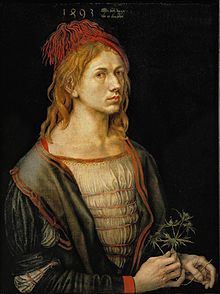
After completing his apprenticeship, Dürer followed the common German custom of taking Wanderjahre—in effect gap years—in which the apprentice learned skills from other masters, their local tradition and individual styles; Dürer was to spend about four years away. He left in 1490, possibly to work under Martin Schongauer, the leading engraver of Northern Europe, but who died shortly before Dürer's arrival at Colmar in 1492. It is unclear where Dürer travelled in the intervening period, though it is likely that he went to Frankfurt and the Netherlands. In Colmar, Dürer was welcomed by Schongauer's brothers, the goldsmiths Caspar and Paul and the painter Ludwig. Later that year, Dürer travelled to Basel to stay with another brother of Martin Schongauer, the goldsmith Georg.[n 1] In 1493 Dürer went to Strasbourg, where he would have experienced the sculpture of Nikolaus Gerhaert. Dürer's first painted self-portrait (now in the Louvre) was painted at this time, probably to be sent back to his fiancée in Nuremberg.[12]

Very soon after his return to Nuremberg, on 7 July 1494, at the age of 23, Dürer was married to Agnes Frey following an arrangement made during his absence. Agnes was the daughter of a prominent brass worker (and amateur harpist) in the city. However, no children resulted from the marriage, and with Albrecht the Dürer name died out. The marriage between Agnes and Albrecht was believed not to be a generally happy one, as indicated by a letter of Dürer in which he quipped to Willibald Pirckheimer in a rough tone about his wife, calling her an "old crow" and made other vulgar remarks. Pirckheimer also made no secret of his antipathy towards Agnes, describing her as a miserly shrew with a bitter tongue, who helped cause Dürer's death at a young age.[13] It has been hypothesized by many scholars that Albrecht was bisexual or homosexual, due to the recurrence of allegedly homoerotic themes in some of his works (e.g. The Men's Bath), and the nature of his correspondence with close friends.[14][15][16]
First journey to Italy (1494–1495)
[edit]Within three months of his marriage, Dürer left for Italy, alone, perhaps stimulated by an outbreak of plague in Nuremberg. He made watercolour sketches as he traveled over the Alps. Some have survived and others may be deduced from accurate landscapes of real places in his later work, for example his engraving Nemesis.
In Italy, he went to Venice to study its more advanced artistic world.[17] Through Wolgemut's tutelage, Dürer had learned how to make prints in drypoint and design woodcuts in the German style, based on the works of Schongauer and the Housebook Master.[17] He also would have had access to some Italian works in Germany, but the two visits he made to Italy had an enormous influence on him. He wrote that Giovanni Bellini was the oldest and still the best of the artists in Venice. His drawings and engravings show the influence of others, notably Antonio del Pollaiuolo, with his interest in the proportions of the body; Lorenzo di Credi; and Andrea Mantegna, whose work he produced copies of while training.[18] Dürer probably also visited Padua and Mantua on this trip.[n 2]
Return to Nuremberg (1495–1505)
[edit]On his return to Nuremberg in 1495, Dürer opened his own workshop (being married was a requirement for this). Over the next five years, his style increasingly integrated Italian influences into underlying Northern forms. Arguably his best works in the first years of the workshop were his woodcut prints, mostly religious, but including secular scenes such as The Men's Bath (c. 1496). These were larger and more finely cut than the great majority of German woodcuts hitherto, and far more complex and balanced in composition.
It is now thought unlikely that Dürer cut any of the woodblocks himself; this task would have been performed by a specialist craftsman. However, his training in Wolgemut's studio, which made many carved and painted altarpieces and both designed and cut woodblocks for woodcut, evidently gave him great understanding of what the technique could be made to produce, and how to work with block cutters. Dürer either drew his design directly onto the woodblock itself, or glued a paper drawing to the block. Either way, his drawings were destroyed during the cutting of the block.
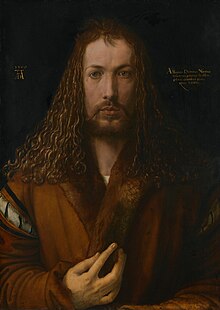
His series of sixteen designs for the Apocalypse[19] is dated 1498, as is his engraving of St. Michael Fighting the Dragon. He made the first seven scenes of the Great Passion in the same year, and a little later, a series of eleven on the Holy Family and saints. The Seven Sorrows Polyptych, commissioned by Frederick III of Saxony in 1496, was executed by Dürer and his assistants c. 1500. In 1502, Dürer's father died. Around 1503–1505 Dürer produced the first 17 of a set illustrating the Life of the Virgin, which he did not finish for some years. Neither these nor the Great Passion were published as sets until several years later, but prints were sold individually in considerable numbers.[12]
During the same period Dürer perfected the difficult art of using the burin to make engravings. Most likely he had learned this skill during his early training with his father, as it was also an essential skill of the goldsmith. In 1496 he executed the Prodigal Son, which the Italian Renaissance art historian Giorgio Vasari singled out for praise some decades later, noting its Germanic quality. He was soon producing some spectacular and original images, notably Nemesis (1502), The Sea Monster (1498), and Saint Eustace (c. 1501), with a highly detailed landscape background and animals. His landscapes of this period, such as Pond in the Woods and Willow Mill, are quite different from his earlier watercolours. There is a much greater emphasis on capturing atmosphere, rather than depicting topography. He made a number of Madonnas, single religious figures, and small scenes with comic peasant figures. Prints are highly portable and these works made Dürer famous throughout the main artistic centres of Europe within a very few years.[12]
The Venetian artist Jacopo de' Barbari, whom Dürer had met in Venice, visited Nuremberg in 1500, and Dürer said that he learned much about the new developments in perspective, anatomy, and proportion from him.[20] To Dürer it seemed that De' Barbari was unwilling to explain everything he knew, so he began his own studies, which would become a lifelong preoccupation. A series of extant drawings show Dürer's experiments in human proportion, leading to the famous engraving of Adam and Eve (1504), which shows his subtlety while using the burin in the texturing of flesh surfaces.[12] This is the only existing engraving signed with his full name.
Dürer created large numbers of preparatory drawings, especially for his paintings and engravings, and many survive, most famously the Betende Hände (Praying Hands) from circa 1508, a study for an apostle in the Heller altarpiece. He continued to make images in watercolour and bodycolour (usually combined), including a number of still lifes of meadow sections or animals, including his Young Hare (1502) and the Great Piece of Turf (1503).
-
The Men's Bath, c. 1496, woodcut, 39.2 × 28.3 cm, (Art Institute of Chicago)
-
The Prodigal Son (1496), copper engraving, 24.7 × 19.1 cm (Rijksmuseum, Amsterdam)
-
Adam and Eve (1504), copper engraving, 29.8 × 21.1 cm (Morgan Library & Museum, New York)
-
Young Hare, 1502, watercolour and gouache, 25 × 22.5 cm, Albertina, Vienna
-
Large Piece of Turf (1503), watercolour and gouache w/highlighting, 40,8 × 31,5 cm, Albertina
Second journey to Italy (1505–1507)
[edit]
In Italy, he returned to painting, at first producing a series of works executed in tempera on linen. These include portraits and altarpieces, notably, the Paumgartner altarpiece and the Adoration of the Magi. In early 1506, he returned to Venice and stayed there until the spring of 1507.[4] It was in Venice that he took up the material of blue paper, which he used to execute preparatory drawing for paintings he completed there in 1505–1507.[21] By this time Dürer's engravings had attained great popularity and were being copied. In Venice he was given a valuable commission from the emigrant German community for the church of San Bartolomeo. This was the altar-piece known as the Feast of the Rosary (or the Feast of Rose Garlands). It shows Pope Julius II and Emperor Maximilian I, peacefully kneeling in adoration before her throne, both with their crowns taken off. It also includes portraits of members of Venice's German community and of Dürer himself on the upper right holding a designation of his authorship. Besides the Flemish verism in the depiction of the greenery and the garments, and the use of his own hues, the altar-piece shows a strong Italian influence. It was later acquired by the Emperor Rudolf II and taken to Prague.[22]
Nuremberg and the masterworks (1507–1520)
[edit]
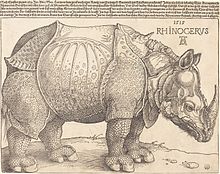
Dürer returned to Nuremberg by mid-1507, remaining in Germany until 1520. His reputation had spread throughout Europe and he was on friendly terms and in communication with many of the major artists including Raphael.[n 3]
Between 1507 and 1511 Dürer worked on some of his most celebrated paintings: Adam and Eve (1507), Martyrdom of the Ten Thousand (1508, for Frederick of Saxony), Virgin with the Iris (1508), the altarpiece Assumption of the Virgin (1509, for Jacob Heller of Frankfurt), and Adoration of the Trinity (1511, for Matthaeus Landauer). During this period he also completed two woodcut series, the Great Passion and the Life of the Virgin, both published in 1511 together with a second edition of the Apocalypse series. The post-Venetian woodcuts show Dürer's development of chiaroscuro modelling effects,[24] creating a mid-tone throughout the print to which the highlights and shadows can be contrasted. Other works from this period include the thirty-seven Little Passion woodcuts, published in 1511, and a set of fifteen small engravings on the same theme in 1512. Complaining that painting did not make enough money to justify the time spent when compared to his prints,[25] he produced no paintings from 1513 to 1516. In 1513 and 1514 Dürer created his three most famous engravings: Knight, Death and the Devil (1513, probably based on Erasmus's Handbook of a Christian Knight),[26] St. Jerome in His Study, and the much-debated Melencolia I (both 1514, the year Dürer's mother died).[n 4] Further outstanding pen and ink drawings of Dürer's period of art work of 1513 were drafts for his friend Pirckheimer. These drafts were later used to design Lusterweibchen chandeliers, combining an antler with a wooden sculpture.
In 1515, he created his woodcut of a Rhinoceros which had arrived in Lisbon from a written description and sketch by another artist, without ever seeing the animal himself. An image of the Indian rhinoceros, the image has such force that it remains one of his best-known and was still used in some German school science text-books as late as last century.[12] In the years leading to 1520 he produced a wide range of works, including the woodblocks for the first western printed star charts in 1515[28] and portraits in tempera on linen in 1516. His only experiments with etching came in this period, producing five between 1515–1516 and a sixth in 1518; a technique he may have abandoned as unsuited to his aesthetic of methodical, classical form.[29]
Patronage of Maximilian I
[edit]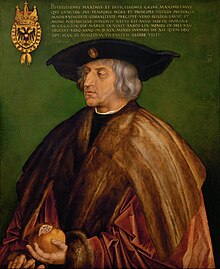

From 1512, Maximilian I became Dürer's major patron. He commissioned The Triumphal Arch, a vast work printed from 192 separate blocks, the symbolism of which is partly informed by Pirckheimer's translation of Horapollo's Hieroglyphica. The design program and explanations were devised by Johannes Stabius, the architectural design by the master builder and court-painter Jörg Kölderer and the woodcutting itself by Hieronymous Andreae, with Dürer as designer-in-chief. The Arch was followed by The Triumphal Procession completed c. 1512.
Dürer worked with pen on the marginal images for an edition of the Emperor's printed prayer book; these were quite unknown until facsimiles were published in 1808 as part of the first book published in lithography. Dürer's work on the book was halted for an unknown reason, and the decoration was continued by artists including Lucas Cranach the Elder and Hans Baldung. Dürer also made several portraits of the Emperor, including one shortly before Maximilian's death in 1519.
Maximilian was a very cash-strapped prince who sometimes failed to pay, yet turned out to be Dürer's most important patron.[30][31][32] In his court, artists and learned men were respected, which was not common at that time (later, Dürer commented that in Germany, as a non-noble, he was treated as a parasite).[33][34] Pirckheimer (who he met in 1495, before entering the service of Maximilian) was also an important personage in the court and great cultural patron, who had a strong influence on Dürer as his tutor in classical knowledge and humanistic critical methodology, as well as collaborator.[35][36] In Maximilian's court, Dürer also collaborated with a great number of other brilliant artists and scholars of the time who became his friends, like Johannes Stabius, Konrad Peutinger, Conrad Celtes, and Hans Tscherte (an imperial architect).[37][38][39][40]
Dürer was proud of his ability.[41] When the emperor tried to sketch Dürer an idea on charcoa, Dürer took the material from Maximilian's hand, finished the drawing and told him: "This is my scepter."[42][43][44] On another occasion, Maximilian noticed that the ladder Dürer used was too short and unstable, thus told a noble to hold it for him. The noble refused, saying that it was beneath him to serve a non-noble. Maximilian then came to hold the ladder himself, and told the noble that he could make a noble out of a peasant any day, but he could not make an artist like Dürer out of a noble.[45][46][47]

This story and a 1849 painting depicting it by August Siegert have become relevant recently. This nineteenth-century painting shows Dürer painting a mural at St. Stephen's Cathedral, Vienna. Apparently, this reflects a seventeenth-century "artists' legend" about the previously mentioned encounter (in which the emperor held the ladder) – that this encounter corresponds with the period Dürer was working on the Viennese murals. In 2020, during restoration work, art connoisseurs discovered a piece of handwriting now attributed to Dürer, suggesting that the Nuremberg master had actually participated in creating the murals at St. Stephen's Cathedral. In the recent 2022 Dürer exhibition in Nuremberg (in which the drawing technique is also traced and connected to Dürer's other works), the identity of the commissioner is discussed. Now the painting of Siegert (and the legend associated with it) is used as evidence to suggest that this was Maximilian. Dürer is historically recorded to have entered the emperor's service in 1511, and the mural's date is calculated to be around 1505, but it is possible they have known and worked with each other earlier than 1511.[48][49][50]
Cartographic and astronomical works
[edit]Dürer's exploration of space led to a relationship and cooperation with the court astronomer Johannes Stabius.[51] Stabius also often acted as Dürer's and Maximilian's go-between for their financial problems.[52]
In 1515 Dürer and Stabius created the first world map projected on a solid geometric sphere.[53] Also in 1515, Stabius, Dürer and the astronomer Konrad Heinfogel produced the first planispheres of both southern and northerns hemispheres, as well as the first printed celestial maps, which prompted the revival of interest in the field of uranometry throughout Europe.[54][55][56][57]
Journey to the Netherlands (1520–1521)
[edit]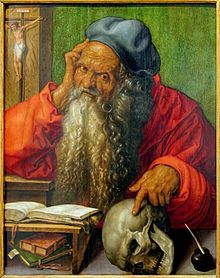
Maximilian's death came at a time when Dürer was concerned he was losing "my sight and freedom of hand" (perhaps caused by arthritis) and increasingly affected by the writings of Martin Luther.[58] In July 1520 Dürer made his fourth and last major journey, to renew the Imperial pension Maximilian had given him and to secure the patronage of the new emperor, Charles V, who was to be crowned at Aachen. Dürer journeyed with his wife and her maid via the Rhine to Cologne and then to Antwerp, where he was well received and produced numerous drawings in silverpoint, chalk and charcoal. In addition to attending the coronation, he visited Cologne (where he admired the painting of Stefan Lochner), Nijmegen, 's-Hertogenbosch, Bruges (where he saw Michelangelo's Madonna of Bruges), Ghent (where he admired Jan van Eyck's Ghent Altarpiece),[59] and Zeeland.
Dürer took a large stock of prints with him and wrote in his diary to whom he gave, exchanged or sold them, and for how much. This provides rare information of the monetary value placed on prints at this time. Unlike paintings, their sale was very rarely documented.[60] While providing valuable documentary evidence, Dürer's Netherlandish diary also reveals that the trip was not a profitable one. For example, Dürer offered his last portrait of Maximilian to his daughter, Margaret of Austria, but eventually traded the picture for some white cloth after Margaret disliked the portrait and declined to accept it. During this trip he also met Bernard van Orley, Jan Provoost, Gerard Horenbout, Jean Mone, Joachim Patinir and Tommaso Vincidor, though he did not, it seems, meet Quentin Matsys.[61]
Having secured his pension, Dürer returned home in July 1521, having caught an undetermined illness, which afflicted him for the rest of his life, and greatly reduced his rate of work.[12]
Final years, Nuremberg (1521–1528)
[edit]
On his return to Nuremberg, Dürer worked on a number of grand projects with religious themes, including a crucifixion scene and a sacra conversazione, though neither was completed.[62] This may have been due in part to his declining health, but perhaps also because of the time he gave to the preparation of his theoretical works on geometry and perspective, the proportions of men and horses, and fortification.
However, one consequence of this shift in emphasis was that during the last years of his life, Dürer produced comparatively little as an artist. In painting, there was only a portrait of Hieronymus Holtzschuher, a Madonna and Child (1526), Salvator Mundi (1526), and two panels showing St. John with St. Peter and St. Paul with St. Mark beside him. This last great work, the Four Apostles, was given by Dürer to the City of Nuremberg—although he was given 100 guilders in return.[63]
As for engravings, Dürer's work was restricted to portraits and illustrations for his treatise. The portraits include his boyhood friend Willibald Pirckheimer, Cardinal-Elector Albert of Mainz; Frederick the Wise, elector of Saxony; Philipp Melanchthon, and Erasmus of Rotterdam. For those of the Cardinal, Melanchthon, and Dürer's final major work, a drawn portrait of the Nuremberg patrician Ulrich Starck, Dürer depicted the sitters in profile.
Despite complaining of his lack of a formal classical education, Dürer was greatly interested in intellectual matters and learned much from Willibald Pirckheimer, whom he no doubt consulted on the content of many of his images.[64] He also derived great satisfaction from his friendships and correspondence with Erasmus and other scholars. Dürer succeeded in producing two books during his lifetime. The Four Books on Measurement were published at Nuremberg in 1525 and was the first book for adults on mathematics in German,[12] as well as being cited later by Galileo and Kepler. The other, a work on city fortifications, was published in 1527. The Four Books on Human Proportion were published posthumously, shortly after his death in 1528.[4]
Dürer died in Nuremberg at the age of 56, leaving an estate valued at 6,874 florins – a considerable sum. He is buried in the Johannisfriedhof cemetery. His large house (purchased in 1509 from the heirs of the astronomer Bernhard Walther), where his workshop was located and where his widow lived until her death in 1539, remains a prominent Nuremberg landmark.[12]
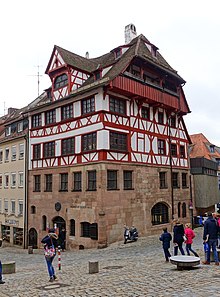
Dürer and the Reformation
[edit]Dürer's writings suggest that he may have been sympathetic to Luther's ideas, though it is unclear if he ever left the Catholic Church. Dürer wrote of his desire to draw Luther in his diary in 1520: "And God help me that I may go to Dr. Martin Luther; thus I intend to make a portrait of him with great care and engrave him on a copper plate to create a lasting memorial of the Christian man who helped me overcome so many difficulties."[65] In a letter to Nicholas Kratzer in 1524, Dürer wrote, "because of our Christian faith we have to stand in scorn and danger, for we are reviled and called heretics". Most tellingly, Pirckheimer wrote in a letter to Johann Tscherte in 1530: "I confess that in the beginning I believed in Luther, like our Albert of blessed memory ... but as anyone can see, the situation has become worse." Dürer may even have contributed to the Nuremberg City Council's mandating Lutheran sermons and services in March 1525. Notably, Dürer had contacts with various reformers, such as Zwingli, Andreas Karlstadt, Melanchthon, Erasmus and Cornelius Grapheus from whom Dürer received Luther's Babylonian Captivity in 1520.[66] Yet Erasmus and C. Grapheus are better said to be Catholic change agents. Also, from 1525, "the year that saw the peak and collapse of the Peasants' War, the artist can be seen to distance himself somewhat from the [Lutheran] movement..."[67]
Dürer's later works have also been claimed to show Protestant sympathies. His 1523 The Last Supper woodcut has often been understood to have an evangelical theme, focusing as it does on Christ espousing the Gospel, as well as the inclusion of the Eucharistic cup, an expression of Protestant utraquism,[68] although this interpretation has been questioned.[69] The delaying of the engraving of St. Philip, completed in 1523 but not distributed until 1526, may have been due to Dürer's uneasiness with images of saints; even if Dürer was not an iconoclast, in his last years he evaluated and questioned the role of art in religion.[70]
Theoretical works
[edit]In all his theoretical works, in order to communicate his theories in the German language rather than in Latin, Dürer used graphic expressions based on a vernacular, craftsmen's language. For example, Schneckenlinie ("snail-line") was his term for a spiral form. Thus, Dürer contributed to the expansion in German prose which Luther had begun with his translation of the Bible.[63]
Four Books on Measurement
[edit]This section needs additional citations for verification. (May 2017) |
Dürer's work on geometry is called the Four Books on Measurement (Underweysung der Messung mit dem Zirckel und Richtscheyt or Instructions for Measuring with Compass and Ruler).[71] The first book focuses on linear geometry. Dürer's geometric constructions include helices, conchoids and epicycloids. He also draws on Apollonius, and Johannes Werner's Libellus super viginti duobus elementis conicis of 1522.
The second book moves onto two-dimensional geometry, i.e. the construction of regular polygons.[72] Here Dürer favours the methods of Ptolemy over Euclid. The third book applies these principles of geometry to architecture, engineering and typography. In architecture Dürer cites Vitruvius but elaborates his own classical designs and columns. In typography, Dürer depicts the geometric construction of the Latin alphabet, relying on Italian precedent. However, his construction of the Gothic alphabet is based upon an entirely different modular system. The fourth book completes the progression of the first and second by moving to three-dimensional forms and the construction of polyhedra. Here Dürer discusses the five Platonic solids, as well as seven Archimedean semi-regular solids, as well as several of his own invention.
Four Books on Human Proportion
[edit]
Dürer's work on human proportions is called the Four Books on Human Proportion (Vier Bücher von menschlicher Proportion) of 1528.[73] The first book was mainly composed by 1512/13 and completed by 1523, showing five differently constructed types of both male and female figures, all parts of the body expressed in fractions of the total height. Dürer based these constructions on both Vitruvius and empirical observations of "two to three hundred living persons",[63] in his own words. The second book includes eight further types, broken down not into fractions but an Albertian system, which Dürer probably learned from Francesco di Giorgio's De harmonica mundi totius of 1525. In the third book, Dürer gives principles by which the proportions of the figures can be modified, including the mathematical simulation of convex and concave mirrors; here Dürer also deals with human physiognomy. The fourth book is devoted to the theory of movement.[20]
Appended to the last book, however, is a self-contained essay on aesthetics, which Dürer worked on between 1512 and 1528, and it is here that we learn of his theories concerning 'ideal beauty'. Dürer rejected Alberti's concept of an objective beauty, proposing a relativist notion of beauty based on variety. Nonetheless, Dürer still believed that truth was hidden within nature, and that there were rules which ordered beauty, even though he found it difficult to define the criteria for such a code. In 1512/13 his three criteria were function ("Nutz"), naïve approval ("Wohlgefallen") and the happy medium ("Mittelmass"). However, unlike Alberti and Leonardo, Dürer was most troubled by understanding not just the abstract notions of beauty but also as to how an artist can create beautiful images. Between 1512 and the final draft in 1528, Dürer's belief developed from an understanding of human creativity as spontaneous or inspired to a concept of 'selective inward synthesis'.[63] In other words, that an artist builds on a wealth of visual experiences in order to imagine beautiful things. Dürer's belief in the abilities of a single artist over inspiration prompted him to assert that "one man may sketch something with his pen on half a sheet of paper in one day, or may cut it into a tiny piece of wood with his little iron, and it turns out to be better and more artistic than another's work at which its author labours with the utmost diligence for a whole year".[74]
-
Title page of Vier Bücher von menschlicher Proportion showing the monogram signature of artist
-
Dürer often used multiview orthographic projections.
-
Dürer's study of human proportions
Book on Fortification
[edit]In 1527, Dürer also published Various Lessons on the Fortification of Cities, Castles, and Localities (Etliche Underricht zu Befestigung der Stett, Schloss und Flecken). It was printed in Nuremberg, probably by Hieronymus Andreae and reprinted in 1603 by Johan Janssenn in Arnhem. In 1535 it was also translated into Latin as On Cities, Forts, and Castles, Designed and Strengthened by Several Manners: Presented for the Most Necessary Accommodation of War (De vrbibus, arcibus, castellisque condendis, ac muniendis rationes aliquot : praesenti bellorum necessitati accommodatissimae), published by Christian Wechel (Wecheli/Wechelus) in Paris.[75]
Fencing
[edit]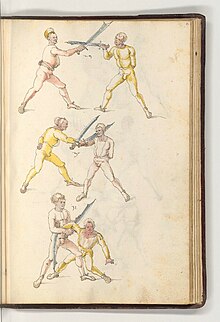
Dürer created many sketches and woodcuts of soldiers and knights over the course of his life. His most significant martial works, however, were made in 1512 as part of his efforts to secure the patronage of Maximilian I. Using existing manuscripts from the Nuremberg Group as his reference, his workshop produced the extensive Οπλοδιδασκαλια sive Armorvm Tractandorvm Meditatio Alberti Dvreri ("Weapon Training, or Albrecht Dürer's Meditation on the Handling of Weapons", MS 26-232). Another manuscript based on the Nuremberg texts as well as one of Hans Talhoffer's works, the untitled Berlin Picture Book (Libr.Pict.A.83), is also thought to have originated in his workshop around this time. These sketches and watercolours show the same careful attention to detail and human proportion as Dürer's other work, and his illustrations of grappling, long sword, dagger, and messer are among the highest-quality in any fencing manual.[76]
Legacy and influence
[edit]Dürer exerted a huge influence on the artists of succeeding generations, especially in printmaking, the medium through which his contemporaries mostly experienced his art, as his paintings were predominantly in private collections located in only a few cities. His success in spreading his reputation across Europe through prints was undoubtedly an inspiration for major artists such as Raphael, Titian, and Parmigianino, all of whom collaborated with printmakers to promote and distribute their work.
His engravings seem to have had an intimidating effect upon his German successors; the "Little Masters" who attempted few large engravings but continued Dürer's themes in small, rather cramped compositions. Lucas van Leyden was the only Northern European engraver to successfully continue to produce large engravings in the first third of the 16th century. The generation of Italian engravers who trained in the shadow of Dürer all either directly copied parts of his landscape backgrounds (Giulio Campagnola, Giovanni Battista Palumba, Benedetto Montagna and Cristofano Robetta), or whole prints (Marcantonio Raimondi and Agostino Veneziano). However, Dürer's influence became less dominant after 1515, when Marcantonio perfected his new engraving style, which in turn travelled over the Alps to also dominate Northern engraving.
Dürer had relatively little influence in Italy, where probably only his altarpiece in Venice was seen, and his German successors were less effective in blending German and Italian styles. His intense and self-dramatizing self-portraits have continued to have a strong influence up to the present, especially on painters in the 19th and 20th century who desired a more dramatic portrait style. Dürer has never fallen from critical favour, and there have been significant revivals of interest in his works in Germany in the Dürer Renaissance of about 1570 to 1630, in the early nineteenth century, and in German nationalism from 1870 to 1945.[12]
The Lutheran Church commemorates Dürer annually on 6 April,[77] along with Michelangelo,[78] Lucas Cranach the Elder and Hans Burgkmair.
In 1993, two of Dürer's drawings – Women's Bathhouse, valued at about $10 million, and Sitting Mary With Child – along with other works of art were stolen from the National Art Museum of Azerbaijan. The drawings were later recovered.[79]
Gallery
[edit]- Religious paintings
-
St Jerome in the Wilderness, c. 1496, oil on pearwood, 23.1 × 17.4 cm, National Gallery, London (NG6563)
-
Christ Among the Doctors, 1506, oil on poplar, 64.3 × 80.3 cm, Thyssen-Bornemisza Museum, Madrid (134 (1934.38)
-
Martyrdom of the Ten Thousand, 1508, oil from wood transferred to canvas, 99 × 87 cm, Kunsthistorisches Museum, Wien (GG 835)
-
Adoration of the Trinity (Landauer Altar), 1511, oil on poplar, 135 × 123.4 cm, Kunsthistorisches Museum (GG 838). The framework is a reconstruction of his design.
- Portraits
-
Portrait of Dürer’s Mother Barbara, née Holper, 1490, oil on fir wood, 47.2 × 35.7 cm, Germanisches Nationalmuseum Nuremberg (Gm 1160)
-
Albrecht Dürer the Elder with a Rosary, 1490, oil on panel, 47.5 × 39.5 cm, Uffizi, Florence
-
Portrait of Oswolt Krel, 1499, oil on limewood, 49.6 × 39 cm, Alte Pinakothek, München. Krel was a merchant from Lindau.
-
Portrait of a Young Venetian Woman, 1506, oil on poplar, 28.5 × 21.5 cm, Gemäldegalerie, Berlin (557G). The abstract background suggests the sea.
-
Portrait of Bernhard von Reesen, 1521, 45.5 × 31.5 cm, Gemäldegalerie Alte Meister, Dresden (1871)
-
Portrait of Hieronymus Holzschuher, 1526, oil and paint on limewood, 51 × 37 cm, Gemäldegalerie, Berlin (557E)
- Watercolours
-
Innsbruck Castle Courtyard, c. 1495, watercolour and gouache, 36.8 × 26.9 cm, Albertina, Vienna (3057)
-
Landscape with a Woodland Pool, c. 1497, watercolour and gouache, 26.2 × 35.6 cm, British Museum, London
-
Wing of a European Roller, c. 1500 ("1512" by later hand), watercolour and gouache on parchment, 19.6 × 20 cm, Albertina (4840)
-
Mary among a Multitude of Animals, c. 1506, dark brown ink and watercolour, 31,9 × 24,1 cm, Albertina (3066)
-
Tuft of Cowslips, 1526, gouache on vellum, 19.3 × 16.8 cm, National Gallery of Art
- Drawings
-
Study of a Female Nude from Behind, 1495, brush and pen on paper, 31.6 × 21.2 cm, Louvre, Paris (INV 19058 R)
-
Reclining Nude, 1501, brush and pen(?) w/ highlights and construction lines, 16.9 × 21.8 cm, Albertina (3072)
-
Three Children's Heads, 1506, pen and ink on blue paper with highlights in gouache, 21,8 × 37,9 cm, Bibliothèque nationale de France, Paris
-
Self-Portrait in the Nude, c. 1509, pen and brush, black ink with white lead on green prepared paper, 29 × 15 cm, Klassik Stiftung Weimar (KK106)
-
Portrait of the Artist's Mother at the Age of 63, spring 1514, charcoal on paper, 42.2 × 30.6 cm, Kupferstichkabinett Berlin (KdZ 22)
-
Head of an 93-Year-Old Man, 1521, brush, ink, heightened w/ gouache, on gray-violet prepared paper, 41.5 × 28.2 cm, Albertina (3167). Study for the St. Jerome
- Copper engravings and an etching
-
Christ on the Mount of Olives, 1515, the only surviving printing plate, iron, 22.7 × 16.1 cm, Bamberg State Library
-
Nemesis (The Great Fortune), c. 1501/02, 33.5 × 23.3 cm (National Gallery of Art)
-
St. Christopher, 1521, 11.6 × 7.4 cm (Metropolitan Museum of Art)
-
Portrait of Willibald Pirckheimer, 1524, 19 × 12.4 cm (Metropolitan Museum of Art)
-
The Cannon, 1518, etching, 21.7 × 32 cm (Metropolitan Museum of Art)
- Woodcut prints
-
The Martyrdom of Saint Catherine, c. 1498, carved pearwood block, 39.4 × 28.3 × 2.6 cm, MET, New York
-
The Flagellation, from the Great Passion, c. 1497, 39 × 28 cm, (printed c. 1498–1500, National Gallery of Art)
-
Four Horsemen of the Apocalypse, 1498, 39.5 × 28.5 cm (NGA, 142352)
-
The Expulsion from Paradise from the Small Passion, 1510, 12.5 × 9.8 cm (NGA)
-
Coat of arms, which features a door as a pun on his name, and the winged bust of a Moor (1523), 35.1 × 26.1 cm (MET)
List of works
[edit]- List of paintings by Albrecht Dürer
- List of engravings by Albrecht Dürer
- List of woodcuts by Albrecht Dürer
References
[edit]Notes
[edit]- ^ Here he produced a woodcut of St Jerome as a frontispiece for Nicholaus Kessler's Epistolare beati Hieronymi. Erwin Panofsky argues that this print combined the "Ulmian style" of Koberger's Lives of the Saints (1488) and that of Wolgemut's workshop. Panofsky (1945), 21
- ^ The evidence for this trip is not conclusive; the suggestion it happened is supported by Panofsky (1945) and is accepted by a majority of scholars, including the several curators of the large 2020–22 exhibition "Dürer's Journeys", but it has been disputed by other scholars, including Katherine Crawford Luber (in her Albrecht Dürer and the Venetian Renaissance, 2005)
- ^ According to Vasari, Dürer sent Raphael a self-portrait in watercolour, and Raphael sent back multiple drawings. One is dated 1515 and has an inscription by Dürer (or one of his heirs) affirming that Raphael sent it to him. See Salmi, Mario; Becherucci, Luisa; Marabottini, Alessandro; Tempesti, Anna Forlani; Marchini, Giuseppe; Becatti, Giovanni; Castagnoli, Ferdinando; Golzio, Vincenzo (1969). The Complete Work of Raphael. New York: Reynal and Co., William Morrow and Company. pp. 278, 407. Dürer describes Giovanni Bellini as "very old, but still the best in painting".[23]
- ^ In March of this year, two months before his mother died, he drew a portrait of her.[27]
Citations
[edit]- ^ a b Wells, John C. (2008), Longman Pronunciation Dictionary (3rd ed.), Longman, ISBN 978-1405881180
- ^ "Albrecht – Deutsch – Langenscheidt Französisch-Deutsch Wörterbuch" (in German and French). Langenscheidt. Retrieved 22 October 2018.
- ^ "Duden | Dürer | Rechtschreibung, Bedeutung, Definition". Duden (in German). Retrieved 22 October 2018.
- ^ a b c Müller, Peter O. (1993) Substantiv-Derivation in Den Schriften Albrecht Dürers, Walter de Gruyter. ISBN 3-11-012815-2.
- ^ Brand Philip & Anzelewsky (1978–79), 11.
- ^ a b c Bartrum, 93, n. 1.
- ^ a b Heaton, Mrs. Charles (1881). The Life of Albrecht Dürer of Nürnberg: With a Translation of His Letters and Journal and an Account of His Works. London: Seeley, Jackson and Halliday. pp. 29, 31–32.
- ^ "Albrecht Dürer (1471 -1528) and Hungary - Hungarian-Ottoman Wars". 4 May 2020.
- ^ Brion (1960), 16.
- ^ Brand Philip & Anzelewsky (1978–79), 10.
- ^ Joseph Koerner, The Moment of Self-Portraiture in Renaissance Art, University of Chicago Press, 1993.
- ^ a b c d e f g h i j k Giulia Bartrum, Albrecht Dürer and his Legacy, British Museum Press, 2002, ISBN 0-7141-2633-0.
- ^ Harry John Wilmot-Buxton; Edward John Poynter (1881). German, Flemish and Dutch Painting. Scribner and Welford. p. 24.
- ^ George Haggerty (2013). Encyclopedia of Gay Histories and Cultures. Taylor & Francis. p. 262. ISBN 978-1-135-58513-6.
- ^ Brisman, Shira, Albrecht Dürer and the Epistolary Mode of Address, University of Chicago Press, 2017, p. 179.
- ^ Mills, Robert, Seeing Sodomy in the Middle Ages, University of Chicago Press, 2015, p. 332, n. 93.
- ^ a b Lee, Raymond L. & Alistair B. Fraser. (2001) The Rainbow Bridge, Penn State Press. ISBN 0-271-01977-8.
- ^ Campbell, Angela and Raftery, Andrew. "Remaking Dürer: Investigating the Master Engravings by Masterful Engraving", Art in Print Vol. 2 No. 4 (November–December 2012).
- ^ "Johannesapokalypse in klassischen Comics".
- ^ a b Schaar, Eckhard. "A Newly Discovered Proportional Study by Dürer in Hamburg". Master Drawings, vol. 36, no. 1, 1998. pp. 59–66. JSTOR 1554333
- ^ Brahms, Iris (2023). "Ecologies of Blue Paper. Dürer and Beyond". 21: Inquiries into Art, History and the Visual (4): 603–638.
- ^ Kotková, Olga. "'The Feast of the Rose Garlands': What Remains of Dürer?". The Burlington Magazine, Volume 144, No. 1186, 2002. 4–13. JSTOR 889418
- ^ Giovanni Bellini, The J. Paul Getty Museum.
- ^ Panofsky (1945), 135.
- ^ Panofsky (1945), p. 44.
- ^ "Knight, Death, and the Devil, 1513–14". Metropolitan Museum of Art. Retrieved 11 September 2020.
- ^ Tatlock, Lynne. Enduring Loss in Early Modern Germany. Brill Academic Publishers, 2010. 116. ISBN 90-04-18454-6.
- ^ Ridpath, Ian. "Dürer's hemispheres of 1515 – the first European printed star charts". Star Tales. Archived from the original on 30 October 2023.
- ^ Cohen, Brian D (September–October 2017). "Freedom and Resistance in the Act of Engraving (or, Why Dürer Gave up on Etching)". Art in Print. Vol. 7 No. 3. Archived from the original on 11 November 2022.
- ^ McCorquodale, Charles (1994). The Renaissance: European Painting, 1400–1600. Studio Editions. p. 261. ISBN 978-1-85891-892-1. Retrieved 3 December 2021.
- ^ Cust, Lionel (1905). The Engravings of Albrecht Dürer. Seeley and Company, limited. p. 66. Retrieved 3 December 2021.
- ^ Brion, Marcel (1960). Dürer: His Life and Work. Tudor Publishing Company. p. 233. Retrieved 3 December 2021.
- ^ Innes, Mary; Kay, Charles De (1911). Schools of Painting. G. P. Putnam's sons. p. 214. Retrieved 3 December 2021.
- ^ Schäfer, Sandra (27 March 2019). "Erfolgreiche Medienarbeit für die Nachwelt". Kulturfüchsin (in German). Retrieved 3 December 2021.
- ^ Streissguth, Tom (2007). The Renaissance. Greenhaven Publishing LLC. p. 254. ISBN 978-0-7377-3216-0. Retrieved 4 December 2021.
- ^ Smith, Jeffrey Chipps (2014). Nuremberg, a Renaissance City, 1500–1618. University of Texas Press. p. 120. ISBN 978-1-4773-0638-3. Retrieved 4 December 2021.
- ^ Co, E. P. Goldschmidt & (1925). Rare and Valuable Books ... E.P. Goldschmidt & Company, Limited. p. 125. Retrieved 4 December 2021.
- ^ Merback, Mitchell B. (2017). Perfection's Therapy: An Essay on Albrecht Dürer's Melencolia I. MIT Press. pp. 155, 258. ISBN 978-1-942130-00-0. Retrieved 4 December 2021.
- ^ Conway, Sir William Martin; Conway, William Martin Sir; Dürer, Albrecht (1889). Literary Remains of Albrecht Dürer. University Press. pp. 26–30. Retrieved 4 December 2021.
- ^ Allen, L. Jessie (1903). Albrecht Dürer. Methuen. p. 180. Retrieved 4 December 2021.
- ^ Bongard, Willi; Mende, Matthias (1971). Dürer Today. Inter Nationes. p. 25. Retrieved 3 December 2021.
- ^ Headlam, Cecil (1900). The Story of Nuremberg. J. M. Dent & Company. p. 73. Retrieved 4 December 2021.
- ^ Seton-Watson, Robert William (1902). Maximilian I, Holy Roman Emperor: Stanhope Historical Essay 1901. Constable. p. 96. Retrieved 4 December 2021.
- ^ Bledsoe, Albert Taylor; Herrick, Sophia M'Ilvaine Bledsoe (1965). The Southern Review. AMS Press. p. 114. Retrieved 4 December 2021.
- ^ Nüchter, Friedrich (1911). Albrecht Dürer, His Life and a Selection of His Works: With Explanatory Comments by Dr. Friedrich Nüchter. Macmillan and Company, limited. p. 22. Retrieved 4 December 2021.
- ^ Carl, Klaus (2013). Dürer. Parkstone International. p. 36. ISBN 978-1-78160-625-4. Retrieved 4 December 2021.
- ^ Landfester, Manfred; Cancik, Hubert; Schneider, Helmuth; Gentry, Francis G. (2006). Brill's New Pauly: Encyclopaedia of the Ancient World. Classical tradition. Brill. p. 305. ISBN 978-90-04-14221-3. Retrieved 4 December 2021.
- ^ Cascone, Sarah (10 January 2020). "Astounded Scholars Just Found What Appears to Be a Previously Unknown Work by Albrecht Dürer in a Church's Gift Shop". Artnet News. Retrieved 17 July 2022.
- ^ "AlbrECHT DÜRER? (2022)". museen.de. Retrieved 17 July 2022.
- ^ "Albrecht Dürer gibt weiter Rätsel auf". Mittelbayerische Zeitung (in German). Retrieved 17 July 2022.
- ^ Crane, Nicholas (2010). Mercator: The Man who Mapped the Planet. Orion. p. 74. ISBN 978-0-297-86539-1. Retrieved 7 November 2021.
- ^ Conway, Sir William Martin; Conway, William Martin Sir; Dürer, Albrecht (1889). Literary Remains of Albrecht Dürer. University Press. p. 27. Retrieved 7 November 2021.
- ^ Crane 2010, p. 74.
- ^ Noflatscher, Heinz (2011). Maximilian I. (1459–1519): Wahrnehmung – Übersetzungen – Gender (in German). StudienVerlag. p. 245. ISBN 978-3-7065-4951-6. Retrieved 7 November 2021.
- ^ Lachièze-Rey, Marc; Luminet, Jean-Pierre; France, Bibliothèque nationale de (2001). Celestial Treasury: From the Music of the Spheres to the Conquest of Space. Cambridge University Press. p. 86. ISBN 978-0-521-80040-2. Retrieved 7 November 2021.
- ^ Nothaft, C. Philipp E. (2018). Scandalous Error: Calendar Reform and Calendrical Astronomy in Medieval Europe. Oxford University Press. p. 278. ISBN 978-0-19-252018-0. Retrieved 7 November 2021.
- ^ Sauter, Michael J. (2018). The Spatial Reformation: Euclid Between Man, Cosmos, and God. University of Pennsylvania Press. p. 98. ISBN 978-0-8122-9555-9. Retrieved 7 November 2021.
- ^ Bartrum, 204. Quotation from a letter to the secretary of the Elector of Saxony.
- ^ Borchert (2011), 101.
- ^ Landau & Parshall: 350–354 and passim.
- ^ Panofsky (1945), 209.
- ^ Panofsky (1945), 223.
- ^ a b c d Panofsky (1945).
- ^ Corine Schleif (2010), "Albrecht Dürer between Agnes Frey and Willibald Pirckheimer", The Essential Dürer, ed. Larry Silver and Jeffrey Chipps Smith, Philadelphia, 85–205.
- ^ Price (2003), 225.
- ^ Price (2003), 225–248.
- ^ Wolf (2010), 74.
- ^ Strauss, 1981.
- ^ Price (2003), 254.
- ^ Harbison (1976).
- ^ A. Koyre, "The Exact Sciences", in The Beginnings of Modern Science, edited by Rene Taton, translated by A. J. Pomerans.
- ^ Panofsky (1945), 255.
- ^ Durer, Albrecht (1528). "Hierinn sind begriffen vier Bucher von menschlicher Proportion durch Albrechten Durer von Nurerberg". Hieronymus Andreae Formschneider. Retrieved 6 August 2018.
- ^ Panofsky (1945), 283.
- ^ For a French translation, see Instruction sur la fortification des villes: bourgs et châteaux, trans A. Rathau (Paris 1870).
- ^ Haegedorn, Dierk (2021). Albrecht Dürer – Das Fechtbuch. VST Verlag. ISBN 978-3-932077-50-0.
- ^ Lutheranism 101 edited by Scot A. Kinnaman, CPH, 2010.
- ^ "'What is a Commemoration...', ELCA" (PDF).
- ^ Ralph Blumenthal (19 July 2001). "Twice Stolen, Twice Found: A Case of Art On the Lam". New York Times. Retrieved 5 November 2020.
Sources
[edit]- Bartrum, Giulia. Albrecht Dürer and His Legacy. London: British Museum Press, 2002. ISBN 0-7141-2633-0
- Brand Philip, Lotte; Anzelewsky, Fedja. "The Portrait Diptych of Dürer's parents". Simiolus: Netherlands Quarterly for the History of Art, Volume 10, No. 1, 1978–79, pp. 5–18.
- Brion, Marcel. Dürer. London: Thames and Hudson, 1960
- Harbison, Craig. "Dürer and the Reformation: The Problem of the Re-dating of the St. Philip Engraving". The Art Bulletin, Vol. 58, No. 3, September 1976, pp. 368–373.
- Koerner, Joseph Leo. The Moment of Self-Portraiture in German Renaissance Art. Chicago/London: University of Chicago Press, 1993. ISBN 978-0226449999.
- Landau David; Parshall, Peter. The Renaissance Print. Yale, 1996. ISBN 0-300-06883-2.
- Panofsky, Erwin. The Life and Art of Albrecht Dürer. Princeton, NJ: Princeton University Press, 1945. ISBN 0-691-00303-3
- Price, David Hotchkiss. Albrecht Dürer's Renaissance: Humanism, Reformation and the Art of Faith. Michigan, 2003. ISBN 978-0-4721-1343-9.
- Strauss, Walter L. (ed.). The Complete Engravings, Etchings and Drypoints of Albrecht Durer. Mineola NY: Dover Publications, 1973. ISBN 0-486-22851-7
- Borchert, Till-Holger. Van Eyck to Dürer: The Influence of Early Netherlandish painting on European Art, 1430–1530. London: Thames & Hudson, 2011. ISBN 978-0-500-23883-7
- Wolf, Norbert. Albrecht Dürer. Cologne: Taschen, 2010. ISBN 978-3-8365-1348-7
- Hoffmann, Rainer (2021). Im Paradies: Adam und Eva und der Sündenfall – Albrecht Dürers Darstellungen (in German). Wien. ISBN 978-3-412-52385-5. OCLC 1288194477.
{{cite book}}: CS1 maint: location missing publisher (link)
Further reading
[edit]- Brahms, Iris. Zwischen Licht und Schatten. Zur Tradition der Farbgrundzeichnung bis Albrecht Dürer. Wilhelm Fink Verlag, Paderborn 2016, ISBN 978-3-7705-5899-5.
- Campbell Hutchison, Jane. Albrecht Dürer: A Biography. Princeton University Press, 1990. ISBN 0-6-910-0297-5.
- Demele, Christine. Dürers Nacktheit – Das Weimarer Selbstbildnis. Rhema Verlag, Münster 2012, ISBN 978-3-8688-7008-4.
- Dürer, Albrecht, Of the Just Shaping of Letters, translated by R.T. Nichol from the Latin text, Dover Publ., New York 1965. ISBN 0-486-21306-4.
- Ehrl, Franziska (28 February 2020). "Schlaglicht: Die einzige erhaltene Radierplatte Albrecht Dürers". blog.arthistoricum.net (in German). Saxon State and University Library Dresden and Heidelberg University Library. Retrieved 3 June 2024.
- Hart, Vaughan Anthony (2016). "Navel Gazing. On Albrecht Dürer's Adam and Eve (1504)". The International Journal of Arts Theory and History. 12 (1): 1–10. doi:10.18848/2326-9960/CGP/v12i01/1-10.
- Korolija Fontana-Giusti, Gordana. "The Unconscious and Space: Venice and the Work of Albrecht Dürer", in Architecture and the Unconscious, eds. J. Hendrix and L.Holm, Farnham Surrey: Ashgate, 2016, pp. 27–44, ISBN 978-1-4724-5647-2.
- Schmidt, Sebastian. "'dan sӳ machten dy vürtrefflichen künstner reich'. Zur ursprünglichen Bestimmung von Albrecht Dürers Selbstbildnis im Pelzrock", in Anzeiger des Germanischen Nationalmuseums 2010, pp. 65–82, ISSN 1430-5496.
- Wilhelm, Kurth (ed.). The Complete Woodcuts of Albrecht Durer, Dover Publications, 2000, ISBN 0-486-21097-9.
External links
[edit]- Colvin, Sidney (1911). . Encyclopædia Britannica. Vol. 8 (11th ed.). pp. 697–703.
- The Strange World of Albrecht Dürer Archived 14 July 2015 at the Wayback Machine at the Sterling and Francine Clark Art Institute. 14 November 2010 – 13 March 2011
- Dürer Prints Close-up on YouTube, made to accompany The Strange World of Albrecht Dürer.
- Albrecht Dürer: Vier Bücher von menschlicher Proportion (Nuremberg, 1528). Selected pages scanned from the original work. Historical Anatomies on the Web. US National Library of Medicine.
- Works by or about Albrecht Dürer at the Internet Archive
- Works by Albrecht Dürer at Project Gutenberg
- The Early Duerer Research Project of the Germanisches Nationalmuseum Nuremberg, with a comprehensive bibliography since 1971 (German).
- "Albrecht Dürer (1471–1528)". In Heilbrunn Timeline of Art History. New York: Metropolitan Museum of Art
- Newspaper clippings about Albrecht Dürer in the 20th Century Press Archives of the ZBW
- Albrecht Dürer, exhibition, Albertina, Vienna, 20 September 2019 – 6 January 2020.
- Albrecht Dürer
- 1471 births
- 1528 deaths
- 15th-century engravers
- 15th-century German painters
- 16th-century engravers
- 16th-century German painters
- Animal artists
- Artist authors
- Artists from Nuremberg
- Catholic decorative artists
- Catholic engravers
- Catholic painters
- German draughtsmen
- German engravers
- German Lutherans
- German male painters
- German people of Hungarian descent
- German printmakers
- German Renaissance painters
- German Roman Catholics
- Heraldic artists
- Manuscript illuminators
- Mathematical artists
- People celebrated in the Lutheran liturgical calendar
- Renaissance engravers
- Woodcut designers


